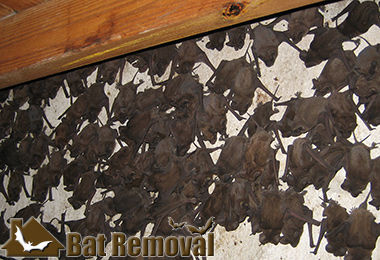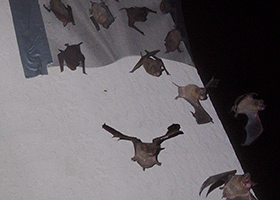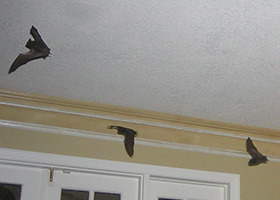Westchester County Bat Removal
Welcome to Westchester County Bat Removal! We are New York bat removal specialists. It is important to know that bats are protected by New York law, and are beneficial animals to have in the environment. We do not kill any bats during our bat removal process. Never hire a pest control company or anyone who says they are a Westchester County bat exterminator. For correct and effective bat removal, you want a company that specializes in humane bat colony extraction. Our process is not only the only legal method in New York, but it is the most effective. We have a 100% success rate in our bat control process. We perform our industry-best 32-point inspection of your house or building, and seal shut all bat entry holes down to 1/4 inch as part of the removal process, during which we remove the colony via special one-way exclusion devices specific to your architecture. Once all bats are safely out, we permanenetly bat-proof the structure. We also provide guano (bat droppings) removal and decon. Click on our Westchester County Bat Control Prices page to find out more about our prices for bat control work. We work 24/7/365, and would love to talk to you about your bat problem. Call us any time at 914-750-4930 to discuss it, discuss our pricing, and if you wish, set up an appointment at your convenience, often same-day.

Westchester County Building and Attic Inspections

No-kill New York Bat Extraction

Guano Cleanouts - Serving all of New York
Call 24/7 to discuss your bat problem.
Same-day or next-day appointments.
32-point inspection of your property.
Written estimates for bat removal project.
Fully state licensed and insured.
Residential and commercial service
100% no-kill Westchester County bat extraction
Complete bat-proofing of your building
Compliance with all New York, federal laws
Guano removal and attic decontamination
Our Service Range - 914-750-4930



4 Tips to Get Rid of the Bats Immediately
Once the bats have invaded your home, you need to look for an immediate solution to avoid incurring damages. The bats invasion will not only carry serious health risks, they can also be the cause of structural damage. Their droppings contain acid that can slowly corrode different materials. Before you start removing them, understand that some of them are protected by the law. You need to know first if it is legal to disturb their roosting site.
How to Quickly Remove the Bats from Your House
By following the tips we will provide here, you will be able to avoid using the solutions that will not work and go straight to the core of the problem. You can also save a great deal of cash by investing your money on the proven effective control method.
1. Identifying Your Bat Infestation
Verifying the problem is an integral part of the removal process. Sometimes, the noise that we are hearing in the attic can be a structural problem. It can also be a sign of a rodent infestation. You need to ensure that the other possibilities have been excluded before we even conduct the removal and exclusion process. Perhaps the best way to identify their presence is by seeing them with your own eyes. If they tend to hide on the obscure places, you can pay attention to the signs that they leave behind such as the bat guano. The droppings of the bat will have undigested food matters.
2. Research
Once you are sure that you are suffering from a bat invasion, you need to know the type of bat that you are housing. You should also know the start of the maternity season. You do not want to separate the mother bat from her babies since this can lead to another problem. Call the local wildlife agency to verify if you can perform your chosen control method. If the bat belongs on the list of protected species, a separate permit will have to be secured.
3. Inspecting your Place
Now that all things are in place, you need to inspect your house to determine how these bats are getting in. The best time to observe their movement would be 10-15 minutes after sunset. Be sure that you have a good view of your house to accurately identify the exit and entry points of these bats.
4. Exclusion and Removal
After identifying all the entry points, start sealing the hole and install the exclusion device on the main hole. Avoid using this method during the maternity season since the mother bat will be persistent in getting back inside your space. The baby bats can also die from dehydration. Dealing with dead bats will be a daunting task. Once you no longer see any sign of bat presence, remove the exclusion device after a week.
Bat removal is a complicated task and should never be done by someone who lack the experience and knowledge. Any mistake can lead to legal problems or health and safety risks.

